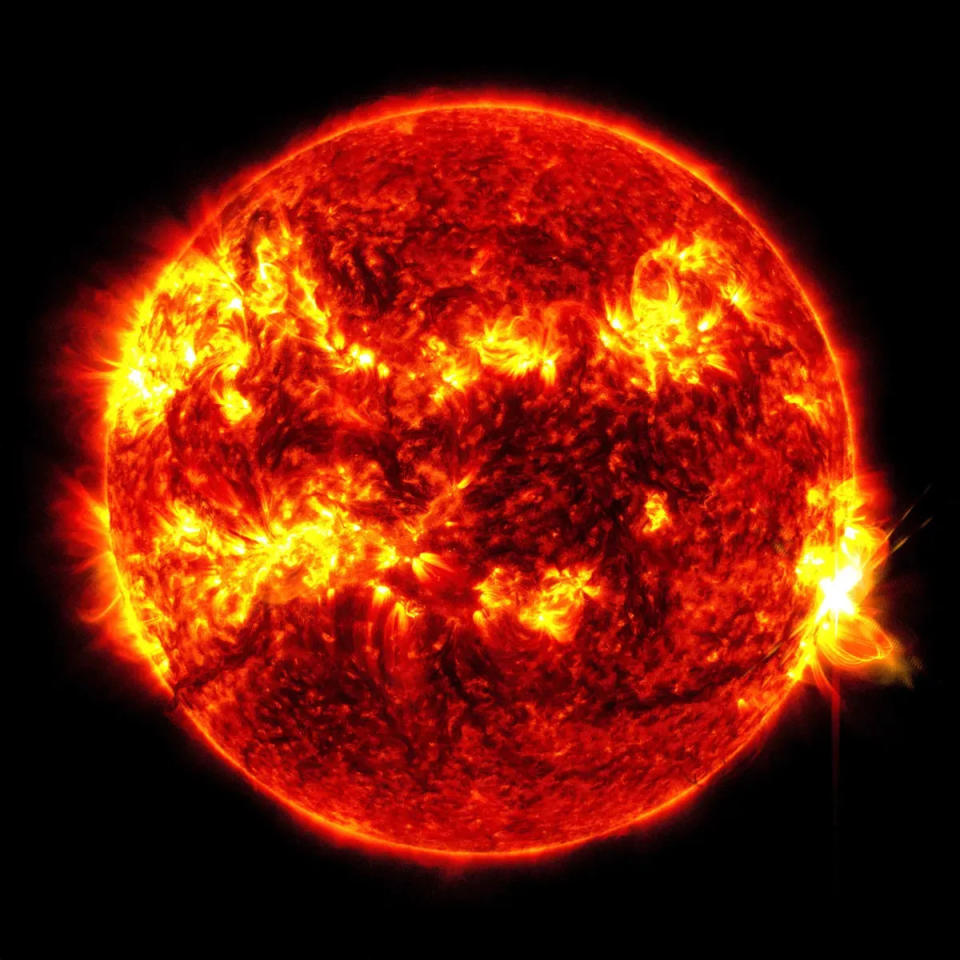NOAA detects another solar flare following sun-produced geomagnetic storm: 'Not done yet'
The sun emitted another powerful solar flare Tuesday nearly one week after separate flares set in motion a severe solar storm that disrupted some technology and produced some mesmerizing northern lights.
The explosive burst of radiation is the largest solar flare detected since 2017, and is by far the biggest of the sun's 11-year solar cycle, according to the National Oceanic and Atmospheric Administration. The eruption occurred following a weekend in which solar flares sent coronal mass ejections hurtling toward Earth that produced the strongest geomagnetic storm in more than two decades.
"Not done yet!" NOAA's Space Weather Prediction Center said in a post on social media site X.
Fortunately, our planet appears to out of striking distance of this particular flare, which was produced on a part of the sun rotating away from Earth.
Here's what to know about the solar flare:
Solar storm: Farmers report GPS disruptions amid planting season due to solar storm
Just how powerful is this solar flare?
Considered our solar system's largest explosive events, solar flares occur when magnetic energy associated with sunspots is released, creating intense bursts of radiation.

Solar flares can last mere minutes, or can drag on for hours, depending on their intensity. NASA classifies solar flares based on their strength, with B-class being the smallest and X-class – which is what was detected Tuesday – being the largest.
Each letter represents a ten-fold increase in energy output and includes a scale of 1 to 9 in each class. The exception is the X-class since there are flares that have been recorded exceeding 10 times the power of an X-1.
REGION 3664 NOT DONE YET! PRODUCES X8.8 FLARE...LARGEST OF THE SOLAR CYCLE! pic.twitter.com/NJZUdRCrt1
— NOAA Space Weather Prediction Center (@NWSSWPC) May 14, 2024
The flare that was detected Tuesday night was classified as an X-8.7 magnitude – far stronger than one in December – according to NOAA, which initially posted that the flare was an X-8.8 before correctly the rating in a follow-up post.
NASA’s Solar Dynamics Observatory, which observes the sun, was able to capture an image of the event, which the agency said peaked at around 12:51 p.m. ET.
Despite X-class rating, solar flare not a threat to Earth
Weaker solar flares won't be noticeable here on Earth, but those with enough energy output to rank as an X-class have the potential to disrupt radio communications, electric power grids and navigation signals. In extreme cases, such powerful flares even pose risks to spacecraft and astronauts, according to NASA.

In the case of the weekend's solar storm, flares erupting on the sun's surface sent coronal mass ejections hurtling toward Earth on Friday to create the powerful event. The geomagnetic storm, which prompted NOAA to issue a watch alert for the first time in 19 years, caused some power grid irregularities and interfered with GPS signals – even farming equipment.
On the bright side, it did also unleash spectacular views of the northern lights in parts of the country where auroras are not often visible.
Tuesday's flare originated on the sun’s western side away from Earth. If the flare produces coronal mass ejections – clouds of plasma and charged particles – it's unlikely to create another geomagnetic storm, NOAA said. However, NOAA did put out a warning that the flare did pose the threat of temporarily disrupting high-frequency radio signals.
Solar flares and other solar activity, such as solar storms, are only expected to become more common by 2025 as the Sun reaches the height of its 11-year cycle, known as the solar maximum.
Eric Lagatta covers breaking and trending news for USA TODAY. Reach him at [email protected]
This article originally appeared on USA TODAY: Sun unleashes strong solar flare days after geomagnetic storm: NOAA
